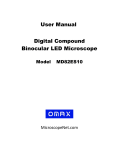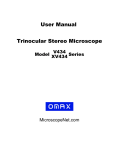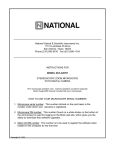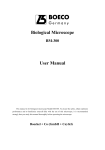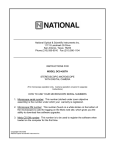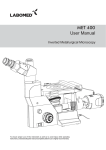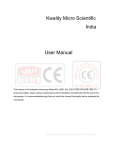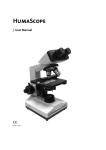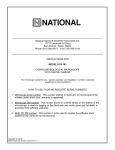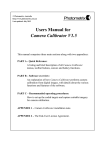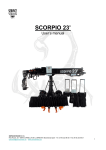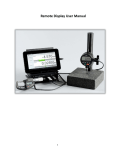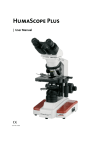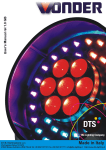Download Master Cover Design
Transcript
User Manual Digital Binocular Compound Microscope Model MD827S30 series MicroscopeNet.com Table of Contents i. Caution……..……………………………………………………………1 ii. Care and Maintenance……….………………………………….….…2 1. Component Illustration………………………….…………………..…3 2. Installation...…………………………………………………………….4 3. Operation……………………….………………………….…………....7 4. Specifications…………………….………………………….……….....10 5. Optional Parts…………………….………………………….………....11 6. Troubleshooting Guide…..................................................................12 7. Darkfield Condenser Installation and Operation Instructions…...…14 8. Phase Contrast Kit Installation and Operation Instructions……..…15 www.microscopenet.com i. Caution 1. Open the carton carefully with a knife or paper cutter. Find the “UP” sign and place the Styrofoam container on the side that makes the arrow upward. If the “UP” sign is missing, please open the Styrofoam container gently to prevent any accessory, i.e. objectives or eyepieces, from dropping and being damaged. 2. Do not discard the molded Styrofoam container. The container should be retained should the microscope ever requires reshipment. 3. Keep the instrument out of direct sunlight, high temperature or humidity, and dusty environments. Ensure that the microscope is located on a smooth, level and firm surface. 4. If any specimen solutions or other liquids splash onto the stage, objective or any other component, disconnect the power cord immediately and wipe up the spillage. Otherwise, the instrument may be damaged. 5. Important: the lamp, lamp housing and adjacent parts will become very hot. Do not touch these parts until they have completely cooled. Never attempt to handle a hot halogen bulb. 6. All electrical connectors (power cord) should be inserted into an electrical surge suppressor to prevent damage due to voltage fluctuations. 7. Confirm that the input voltage indicated on your microscope corresponds to your line voltage. The use of a different input voltage other than that as indicated will cause severe damage to the microscope. -1- www.microscopenet.com ii. Care and Maintenance 1. Do not attempt to disassemble any component including eyepieces, objectives or focusing assembly. 2. Keep the instrument clean; remove dirt and debris regularly. Accumulated dirt on metal surfaces should be cleaned with a damp cloth. More persistent dirt should be removed using a mild soap solution. Do not use organic solvents for cleansing. 3. The outer surface of the optics should be inspected and cleaned periodically using an air stream from an air bulb. If dirt remains on the optical surface, use a soft cloth or cotton swab dampened with a lens cleaning solution (available at camera stores). All optical lenses should be swabbed using a circular motion. A small amount of absorbent cotton wound on the end of a tapered stick makes a useful tool for cleaning recessed optical surfaces. Avoid using an excessive amount of solvents as this may cause problems with optical coatings or cemented optics or the flowing solvent may pick up grease making cleaning more difficult. Oil immersion objectives should be cleaned immediately after use by removing the oil with lens tissue or a clean, soft cloth. 4. Observe the specimen with the 4X, 10X and 40X objectives in order, then observe the specimen with the 100X objective. Apply the immersion oil on the slide cover with the 100X objective. Do not let the immersion oil to contact with the dry objectives lens (especially the 40X). Clean the dry objective lens using the camera cleaning kit if the immersion oil is on the dry objectives lens. Clean the 100X objective lens first using the camera cleaning kit after observing the specimen with the 100X objective, then clean the specimen. More persistent dirt should be removed using a little bit alcohol. Do not use organic solvents for cleansing. 5. Store the instrument in a cool, dry environment. Cover the microscope with the dust cover when not in use. -2- www.microscopenet.com 1 Components Illustration 1 10 2 11 3 12 4 13 5 14 6 15 16 7 17 8 18 9 19 23 20 24 21 22 25 1 2 3 4 5 6 7 Eyepiece 10 Viewing Head w/ Camera 19 Power Switch Diopter Ring 11 Head Thumb Lock Screw 20 Condenser Lock Thumb Knob Eyepiece Tube 12 Microscope Body 21 Condenser Focus Knob Nosepiece 13 Focus Tension Ring 22 Focus Stop Lever Objective 14 Coarse Focus Knob 23 Abbe Condenser Slide Holder 15 Fine Focus Knob 24 Color Filter Holder Mechanical Stage 16 X-Y Stage Moving Knobs 25 Iris Diaphragm Lever 8 Light Collector 17 USB Cable 9 Microscope Base 18 Brightness Intensity Dial -3- www.microscopenet.com 2 Installation 2.1 Installation of the binocular viewing head 1) Loosen the head thumb lock screw on the top of the microscope body and remove the plastic cover on the top 2) Remove the cap on the dovetail of the binocular viewing head 3) Seat the dovetail completely of the viewing head into the socket on the top of the microscope body and tighten the head thumb lock screw. Caution: Do not release the viewing head from your hand grip until you are sure the viewing head is installed securely. 2.2 Installation of the eyepieces 1) Remove the protective caps from the eyepiece tubes. 2) Insert the eyepieces into the eyepiece tubes. 2.3 Installation of the objectives 1) Adjust the coarse focus knob until the mechanical stage is at its lowest position. 2) Turn the caps counter-clockwise to remove them from the nosepiece. 3) Take the objectives out from the plastic cases and turn each one clock-wise into the holes on the nosepiece. Install the 4X objective into the nosepiece first. Then in a counter-clockwise direction, rotate the nosepiece and install each succeeding higher magnification objective as shown in Fig. 1. Fig.1 Note: Inspect the objectives frequently for dirt or oil; clean if necessary. Use the 10X objective to initially focus the image of your specimen. When changing the objective magnification, rotate the objective nosepiece until you hear a “click” sound or have a clear "in position" feeling. This ensures the objective is centered in the optical light path. -4- www.microscopenet.com 2.4 Installation of the glass Filter 1) Swing out the color filter holder under the condenser. 2) Place the filter into the holder as shown in Fig. 2, swing the holder in. Color Filter Color Filter Holder Fig.2 2.5 Installing (or changing) the halogen bulb 1) 2) 3) 4) 5) Turn off the power switch and disconnect the power cord. Allow some time to cool down the lamp. Turn over the microscope on its side; find the bulb compartment at the bottom. Open the cover of the bulb compartment by loosening the thumb screw. Take out the dead halogen bulb and insert the new halogen bulb. Be sure the pins on the bulb are completely inserted into the lamp socket. You may also loosen the two screws on the cover to adjust the position of the bulb to get centered and even brightness. See Fig. 3. 6) Screw the cover on. Halogen Bulb Screws Thumb Screw Fig.3 Caution: Before you turn over the microscope, be sure to take the eyepieces off and be certain that the head is securely locked by the thumb screw. -5- www.microscopenet.com 2.6 Replacing the fuse 1) Turn off the power switch and disconnect the power cord. 2) Turn over the microscope on its side; find the fuse holder at the bottom of the base. 3) Turn the fuse holder counter-clockwise to take it off, replace the fuse, and then turn it on clockwise. See Fig. 4. Fuse Holder Fuse Fig.4 Caution: Before you turn over the microscope, be sure to take the eyepieces off and be certain that the head is securely locked by the thumb screw. 2.7 1) 2) 3) Installing the mirror (optional, may not included in your package) Turn off the power switch and disconnect the power cord. Screw off the light collector on the microscope base. Screw the black disc onto the base and then insert the mirror into the hole at the center of the black disc. See Fig. 5. You may try to get reflected ambient light on either side of the mirror with different angles for best result. Light Collector Fig.5 Mirror Note: The mirror is only used when there is a power failure or you are in the field and no power is available. 2.8 Installation of the darkfield condensers (optional, may not included in your package) Please see section 7 (Darkfield Condenser Installation and Operation Instructions) 2.9 Installation of the phase contrast kits (optional, may not included in your package) Please see section 8 (Phase Contrast Kit Installation and Operation Instructions) -6- www.microscopenet.com 3 Operation 3.1 Adjusting illumination 1) Plug the power cord into the power socket on the microscope and connect it to the power outlet. 2) Turn on the power switch. 3) Rotate the brightness intensity dial to increase or decrease the brightness. Caution: A diffusion filter is attached beneath the condenser to get uniform light and protect your eyes from strong light when a low power objective applied. The diffusion filter can be swung out to make the view field brighter when observing with a high power objective, such as 100X objective. 3.2 Placing specimen 1) Place the slide on the mechanical stage. 2) Use the slide holder to gently secure the slide. 3) Turn the X and Y stage moving knobs to position the specimen in the center of viewing field. Caution: Be sure not to allow an objective to touch a specimen slide when changing objectives. 3.3 Adjusting interpupillary distance While observing with both eyes, hold the left and right eyepiece tubes then slide the tubes in and out. The interpupillary distance is correct when the left and right fields of view converge completely into one image. 3.4 Adjusting eyepiece diopter 1) Rotate the 10x objective into position. 2) Rotate the diopter rings on the eyepiece tubes until its numerical value is the same as your interpupillary distance, for example, 70 in the figure (See Fig. 6). 3) Close your left eye and bring the specimen into focus following the focusing procedures in 3.5. 4) Close your right eye and bring the same specimen into clear sharp focus by adjusting the diopter ring on left eyepiece tube only. Do not use focus knobs at this step. 5) Since both sides are adjustable, you may also do the above in the opposite way, in other words, left eye first and right eye second. -7- 70 Fig.6 www.microscopenet.com 3.5 Focusing 1) With the 10x objective in position, raise the mechanical stage using the coarse focus knob until the specimen is close to the objective. 2) Turn the coarse focus knob until the specimen is in focus. 3) Use the fine focus knob to obtain a sharp image. 4) To get a good focused image, you may need to combine the focus knob adjustment and interpupillary distance adjustment, along with eyepiece diopter adjustment stated in 3.3 and 3.4. Focus Stop Lever 5) You may now switch to another magnification objective. Fig.7 Tips: To prevent your specimen slide from making contact with an objective, raise the stage to its highest position without contacting the 100x objective, then tighten the focus stop lever (Fig. 7). Give the stage a tiny extra moving space to ensure the objective can be focused every time. 3.6 Applying the immersion oil 1) Rotate the objective nosepiece to seat the observing position between the 40X and 100X objectives as shown in Fig. 8 (a). 2) Place a drop of immersion oil on the slide cover as shown in Fig. 8 (b). 3) Rotate the objective nosepiece to seat the 100X objective to the observing position until you hear a “click” sound. 4) After observing the specimen, use the camera cleaning kit to clean the 100X objective lens gently and the specimen in time. 5) If it is hard to clean, you need a little bit alcohol to clean the 100X objective lens and the specimen. Fig.8 (a) (b) Caution (important): When you use the 100X objective to observe the specimen, you have to finish observing the specimen with the 4X, 10X, 40X objectives. When you use the 100X objective to observe the specimen, you have to apply the immersion oil on the top of the slide cover. When you apply the immersion oil with the 100X objective, do not let the immersion oil to contact with the dry objective lenses (especially the 40x). If the immersion oil is on the dry objectives lens, please use the camera cleaning kit to clean the objectives lens in time. The oil will damage the dry objective lenses. After observing the specimen with the 100X objective, clean the 100X objective lens first. -8- www.microscopenet.com 3.7 Adjusting condenser 1) Turn the condenser focus knob to raise or lower the condenser. 2) Raise the condenser when using high power objectives and lower it when using low power objectives. Note: The centering of the condenser and the light axis of the objective are factory adjusted. Do not attempt to re-adjust. The highest position of the condenser has been factory adjusted. Do not attempt to re-adjust. 3.8 Adjusting iris aperture diaphragm Swing the iris diaphragm lever (Fig. 9) left or right to adjust the aperture size. Note: The iris diaphragm is designed to adjust the aperture size, not to adjust the brightness although the brightness will be changed when it's adjusted. When aperture is adjusted to smaller size, the contrast will be increased and the depth of field will be increased as well. Turn up the intensity of the light if the image is too dim. 3.9 Adjusting focus tension The focus tension has been pre-set at the factory. If the mechanical stage drops by itself, rotate the tension adjustment ring (Fig. 10) situated between the coarse focus knob and microscope body on the power switch side until the tension is in maintained. 3.10 Photo/video observing, capturing and recording 1) Insert the USB cable into the USB port (Fig. 11) on the back of viewing head, and the other end to the computer. 2) Turn on the computer; install the camera following the manual in the mini CD. 3) Launch the observing software to examine. 4) You also can capture images or record live videos through the software. Note: For the details of installation and operation of the camera and its software, please refer to the manual in the mini CD. 3.11 Iris Diaphragm Lever Fig.9 Focus Tension Ring Fig.10 USB Port Fig.11 Darkfield condensers observation (optional, may not included in your package) Please see section 7 (Darkfield Condenser Installation and Operation Instructions) 3.12 Phase contrast kits observation (optional, may not included in your package) Please see section 8 (Phase Contrast Kit Installation and Operation Instructions) -9- www.microscopenet.com 4 Specifications Model MD827S30 series Total Magnification 40X, 80X, 100X, 200X, 400X, 800X, 1000X, 2000X Viewing Head Binocular, 45ºinclined, 360ºswiveling w/ built-in camera Interpupillary Distance Sliding adjustment, 55mm-75mm Diopter Adjustment On both eyepiece tubes Eyepieces 1 pair of WF10X/18 1 pair of WF20X Objective Tube Length 160mm Nosepiece Revolving quadruple Objectives Achromatic DIN 4X, 10X, 40X(spring), 100X(spring, oil) Condenser Abbe, NA=1.25, w/ iris diaphragm and filter holder Rack and pinion adjustment Focus Mechanism Coaxial coarse and fine focusing knobs on both sides w/ focus stop Minimum fine focusing adjustment at 0.002mm, range 28mm Mechanical Stage Double layer, Dimension: 5-1/2” x 5-1/2” (140mmx140mm) Translational range: 3” x 2” (75mm X 50mm) Camera Built-in USB2.0 2048 x 1536 pixel (3.0MP) Driver and Software included in the CD Compatible with Windows 2000, XP, Vista and Windows7 (32/64-bit) Darkfield Condensers (optional) Refer to the Darkfield Condensers specifications Phase Contrast Kits (optional) Refer to the Phase Contrast kits specifications Carrying Case (optional) Net weight: 10 lbs 8 oz (4.75 kg) Size: 16-1/2" x 12-1/2"x 13-3/8" (42cm x 32cm x 34cm) Illumination Transmitted: 6V/20W, Halogen, Variable intensity Power Supply AC 100V-240V, 50/60HZ (US and Canada plug) Dimension 7-7/8” x 10-1/4” x 15-3/8” (20cm x 26cm x 39 cm) Net weight 12 lbs (5.45 kg) - 10 - www.microscopenet.com 5 Optional Parts (The optional parts may be included in some models or sold separately.) 1) Darkfield Condensers Model A191 Darkfield Numerical Condenser Aperture Dry 0.7-0.9 Objective Mounting Size(diameter) - 37mm Plan 100X/1.25 oil-0.5 A191BOIL Oil 1.36-1.25 160/0.17(spring), w/ iris 37mm diaphragm 2) Phase Contrast Kits Model Phase Contrast Objective Condenser Annular Ring Plates Plan achromatic 10X with built-in phase plate Plan achromatic 40X with built-in phase plate, spring Plan achromatic 100X with built-in phase plate, spring, oil Achromatic 10X with built-in phase plate Achromatic 20X with built-in phase plate A1PHB3 NA 1.25 Achromatic 40X with built-in phase plate, spring Achromatic 100X with built-in phase plate, spring, oil Achromatic 10X with built-in phase plate A1PHD Telescope five positions: 10 for 10X phase contrast objective 20 for 20X phase contrast objective 40 for 40X phase contrast objective 100 for 100X phase contrast objective B for bright field observation, with iris diaphragm Plan achromatic 20X with built-in phase plate A1PHB1 Centering Achromatic 40X with built-in phase plate, spring Achromatic 100X with built-in phase plate, spring, oil - 11 - five positions: 10 for 10X phase contrast objective 20 for 20X phase contrast objective 40 for 40X phase contrast objective 100 for 100X phase contrast objective B for bright field observation, with iris diaphragm 1 For 10X phase contrast objective 1 For 40X phase contrast objective 1 for 100x phase contrast objective focusing adjustable www.microscopenet.com 6 Troubleshooting Guide GENERAL PROBLEMS Problem Lamp does not light when switched on Darkness at the periphery or uneven brightness in the field of view Dirt or dust on the view Poor image quality or not able to get focused image Cause Solution No electrical power Check power cord connection Lamp bulb burnt out Replace bulb Fuse blown out Replace fuse Revolving nosepiece not in click stop position Revolve the nosepiece to click-stop position by swinging the objective correctly into the optical path The light source of the bulb is not at the center Adjust the position of the bulb Dirt or dust on the lens eyepiece, condenser, objective, collector lens or specimen Clean the lens with a camera cleaning kit No slide cover attached to the slide Attach a 0.17mm slide cover Slide cover is too thick or thin Use a slide cover of the appropriate thickness (0.17mm) Slide may be upside down (specimen at the bottom) Turn slide over so the cover-glass faces up Diopter adjustment is not set properly Readjust the diopter settings Immersion oil is on a dry objective (especially the 40x) Check the objectives, clean if necessary No immersion oil used with 100x objective Use immersion oil Air bubbles in immersion oil Remove bubbles Condenser aperture is closed or open too much Open or close properly Condenser is positioned too low Position the condenser upward Specimen rises from stage surface Secure the specimen in the slide holder Blue filter not used Use daylight blue filter Lamp intensity is too high or low Adjust the light intensity by rotating the intensity control dial - 12 - www.microscopenet.com Slippage of focus when using the coarse focusing knob Fine focus is ineffective Tension adjustment is set too low Increase the tension on the focusing knobs Tension adjustment is set too high Loosen the tension on the focusing knobs DARKFIELD PROBLEMS Problem Cause Solution The light is not on Turn on the light (A191BOIL only) There is no oil in Place a drop of oil on the top lens of condenser and let it contact the underside of slide between the condenser top lens and slide (A191BOIL only) The built-in iris It’s totally dark in the viewing field diaphragm of 100X objective is not in proper position The condenser is not in the right position The intensity of lamp is too low The illumination is insufficient or too bright The condenser is not in the right position The condenser is not centered properly (A191BOIL only) The built-in iris diaphragm of 100X objective is not in proper position The specimen is not suitable for darkfield observation (A191BOIL only) The built-in iris Image of the specimen is not clear and lacking in sufficient contrast diaphragm of 100X objective is not in proper position The condenser is not in the right position - 13 - Adjust the iris diaphragm ring on the objective Lower or raise the condenser slightly to the position that the specimen is the brightest. (A191BOIL only) Make sure the oil contact the bottom of the slide and the top of the condenser during the adjustment. Adjust the intensity dial to increase the brightness Lower or raise the condenser slightly to the position that the specimen is the brightest. (A191BOIL only) Make sure the oil contact the bottom of the slide and the top of the condenser during the adjustment. Adjust the translational centering screws to center the condenser Turn the iris diaphragm ring on the objective Change to brightfield or phase contrast Turn the iris diaphragm ring on the objective Lower or raise the condenser slightly to the position that the specimen is the brightest. (A191BOIL only) Make sure the oil contact the bottom of the slide and the top of the condenser during the adjustment. www.microscopenet.com 7 Darkfield Condenser Installation and Operation Instructions 7.1 Dry darkfield condenser of A191 1) Mounting the dry darkfield condenser Loosen the condenser lock thumb screw on the condenser holder and remove the brightfield condenser. Install the dry darkfield condenser and tighten the condenser lock thumb screw on the condenser holder (see Fig. 12). Condenser Holder Condenser Lock Thumb Screw Centering Screws Fig.12 2) Centering the dry darkfield condenser Turn the 4X objective to the light path. Turn the condenser focus knob to lower the condenser till a dark spot showed in the viewing field as shown in Fig. 13 (a). Turn the condenser translational centering screws to move the dark spot to the center as shown in Fig. 13 (b). 3) Place the slide on the stage. 4) Raise the condenser all the way to the top and lower it a little bit. 5) Following the procedures in this manual to focus and observe. 6) Move the condenser up or down slightly to get the (a) (b) best darkfield viewing. Fig.13 Note: The dry darkfield condenser is used with the dry objectives only. The dry darkfield condenser works with the 4X, 10X, 40X objectives. The dry darkfield condenser won’t work with the 100X oil immersion objective. 7.2 Oil darkfield condenser of A191BOIL 1) Mounting the oil darkfield condensers Loosen the condenser lock thumb screw on the condenser holder and remove the brightfield condenser. Install the oil darkfield condensers and tighten the condenser lock thumb screw on the condenser holder (see Fig. 14). 2) Centering the oil darkfield condensers Turn the 40X objective to the light path. Turn the condenser focus knob to slowly lower and raise the condenser till a dark spot showed in the viewing field as shown in Fig. 15 (a). Turn the condenser translational centering screws to move the dark spot to the center as shown in Fig. 15 (b). - 14 - Condenser Lock Thumb Screw Condenser Holder Centering Screws Fig.14 (a) Fig.15 (b) 3) 4) 5) 6) www.microscopenet.com Raise the condenser till the top lens is close to the opening of stage. Place a drop of immersion oil on the top of the lens of the condenser. Place the slide on the stage. Raise the condenser and let the oil drop contact the bottom of the slide. If air bubbles exist in the oil, clean the oil from the condenser lens and bottom of slide with a camera cleaning paper and repeat the procedures. Follow the procedures in this manual to bring the sample on slide in focus and observe. When using the 100X oil darkfield objective, you will need to drop the Iris Ring immersion oil and adjust the iris ring (Fig. 16) to get proper brightness and contrast of view field. Note: The condenser won’t work well if no oil drop applied on the condenser. Fig.16 8 Phase Contrast Kit Installation and Operation Instructions 8.1 Phase contrast kits of A1PHB1 or A1PHB3: 1) Mounting the phase contrast objectives a. Take off all the objectives from the nosepiece. b. Install the phase contrast objectives onto the nosepiece following the steps in 2.3. 2) Mounting the phase contrast condenser/annular ring disk a. Rotate the nosepiece and set the 4x objective in position. b. Turn the coarse focus knob to raise the mechanical stage to the highest position without contacting the 4X objective. c.Turn the condenser control knob to raise the condenser to the highest position. d. Loosen the light collector and take it off. e. Loosen the condenser lock thumb screw, pull down the condenser and take it off. f. Insert the condenser/annular ring disk into the condenser holder, and tighten the thumb screw. g. Insert the light collector back onto the base and turn until it’s tightened. h. Re-adjust the condenser height to its normal position. i. Re-adjust the mechanical stage height to its normal position. Note: When raising the mechanical stage, do not make contact with the objective. 3) Turn the desired objective into light path. 4) Turn the annular ring disk to put the corresponding ring into light path, i.e. if you are using the 40x phase contrast objective, you should turn the disk at 40 as shown in Fig. 17. - 15 - 40 Fig.17 www.microscopenet.com 5) Centering the annular ring. a. Remove one eyepiece from the microscope eyepiece tube and insert the centering telescope as shown in Fig. 18. b. Observe from the telescope. The bright ring and dark ring should be coincided with each other as shown in Fig.19 (d). c. If the ring images are not clear, turn the top of telescope until both ring images are in focus. d. If the bright ring is still obscure as in Fig.19 (b), Fig.18 adjust the condenser focus knob. e. If the two ring images are not coincided as shown in Fig.19 (c), hold the ring plate from the bottom of the annular ring disk and adjust its position until two ring images are coincided. f. Remove the centering telescope and replace it with the eyepiece. g. Put the specimen on the stage and adjust the (a) (b) illumination, focusing, etc following the instructions in this manual. Note: The phase contrast condenser will be working as a conventional Abbe condenser if the annular ring disk being put at B position. (c) Fig.19 8.2 Phase contrast kit of A1PHD: 1) Mounting the phase contrast kit a. Replace the bright field objective(s) on nosepiece with the phase contrast objective(s) b. Thread the condenser ring plate onto the condenser as shown in Fig.20. c. Loosen the condenser lock thumb screw as shown in Fig. 21; take off the original condenser from the holder. d. Insert the phase contrast condenser into the condenser holder as shown in Fig. 21, tighten the condenser lock thumb screw. Condenser Holder Thumb Screw Fig.21 - 16 - Fig.20 (d) www.microscopenet.com Note: there are 3 phase contrast objectives: 10X, 40X and 100X, and there are 3 condenser ring plates: 10X, 40X and 100X. The corresponding objective and ring plate must work together, i.e. 10X phase contrast objective must work with 10X condenser ring plate, and so on. 2) Centering the condenser ring plate a. Connect the power cord to the microscope and insert the plug into a power outlet. b. Turn the desired phase contrast objective into light path. c. Choose the ring plate that corresponding to the phase contrast objective in light path and screw it on the condenser. d. Replace the bright field condenser with the phase (a) (b) contrast condenser with ring plate on. e. Remove one eyepiece from the microscope eyepiece tube and insert the centering telescope. f. Turn the light of microscope on and observe from the telescope. g. Turn the top of the telescope (Fig.23) until the dark ring image is in focus. If the dark ring is hard to find, put a normal white print paper on the stage and (c) (d) under the objective then you will see the dark ring Fig.22 as shown in Fig.22 (a). h. If the bright ring is still obscure as in Fig.22 (b), raise or lower the condenser by adjusting the condenser focusing knob (or the microscope focusing knob if necessary) till the bright ring is in focus and the dark ring is visible. i. If the two ring images are not coincided as shown in Fig.22 (c), adjust the two centering screws on the condenser ring plate till the two rings are coincided with each other as shown in Fig.22 (d). j. Remove the centering telescope and replace it with the eyepiece. 3) Centering the condenser ring plate After you center the ring plate, you can perform the phase contrast observation the same way as a normal bright field microscope. Note: when change to another phase contrast objective and corresponding condenser ring plate, the focusing and centering of bright ring and dark ring should be repeated following the procedures from 2)-b) to 2)-h. Tips: Make the illumination as bright as possible. The thinner the specimen, the better the image. - 17 - Fig.23



















